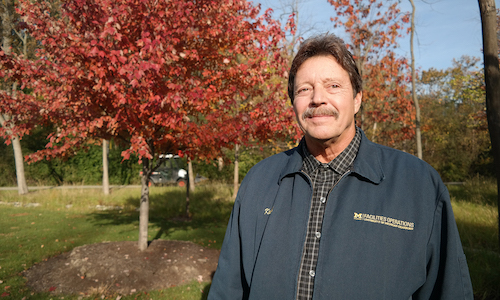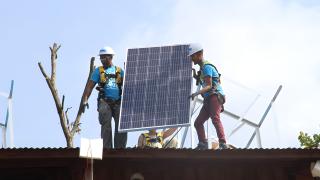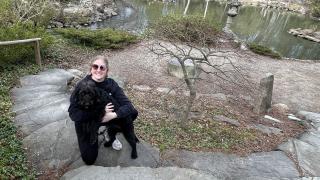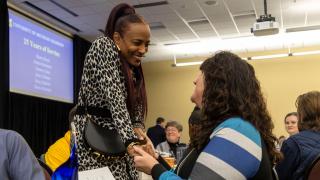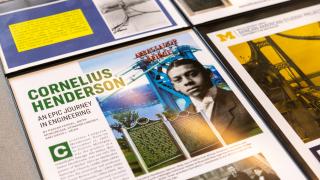
UM-Dearborn’s Landscape and Grounds Manager Keith Sudak is an old-school guy who loves new ideas. When he’s putting together a new landscaping plan, for instance, he still skips AutoCAD and reaches instead for paper and pencil — often colored ones to indicate seasonal foliage — and sometimes with remarks about the fragrance of each plant. However, the designs — and the trees, shrubs and rocks at the heart of those plans — have changed a lot over the years, as Sudak and the UM-Dearborn grounds team have forged ahead with new trends and the best science.
We chatted with Sudak recently about his life in landscaping, and how his team’s ever-evolving approach is making campus both more beautiful and sustainable.
I’m a third-generation landscape guy. Both my dad and his dad were in the landscaping business and I think I must have only been 8 years old when they absorbed me into it. My dad would even take me out of school sometimes to go to these horticulture seminars. It was so cool — I’d be sitting in a room with a group of men and women who did this stuff for a living, and here I am the only kid. I remember they’d always have the newest state-of-the-art technologies, like the infrared lamps that could spot diseased trees. I guess you see that kind of thing as a kid and it’s hard not to get hooked.
I came to UM-Dearborn 16 years ago, and I my first impression was that campus was really well done. My predecessor was a forester, so he was really into trees. But he was also a military guy; and so to him, moving a tree meant getting a crew out there with shovels and using nothing but muscle to do it. In fact, the guys here have a funny story about him moving a tree at the chancellor's house just five feet — I guess to make more room for a neighboring tree.
Here at UM-Dearborn, we’re very fortunate to have such a longstanding crew. A lot of the grounds staff were here when I got here. But campus is always evolving, you know? When I started, it was maybe what I’d call a more industrial look. The style back then was to stage things, with consistency and repetition, so you’d plant a tree and then put in three plants around it. Then, things started to get a little more diverse. And today, we’re going more natural.
One of the things about our campus is that we’re surrounded by little slices of nature, so I really try to bring that natural environment in from the perimeter. For example, we’re taking some of the species that we have in our natural woodlots, like the white oaks or the beech, and mimicking them in plantings closer to the sidewalks and buildings. Even though it’s a planned landscape, the idea is that it starts to feel more like it’s nature that put it there.
My favorite trees on campus are the beech at the main entrance. These trees are pretty darn smart: Scientists have actually figured out this is a species that can communicate, and they use their roots to warn other trees of pests that are invading their space. So that’s one tree that isn’t quiet. You look at the non-native trees in a landscape, and they seem kind of quiet to me in contrast. They don’t quite belong there. But these beech, you just get a feel for them. You can tell they’re a living community.
The land that the campus was built on has a pretty amazing history. For example, when we were working on a project a few years ago, the folks at the Environmental Interpretive Center tipped us off that back in the day, this area was made up of what they call French “ribbon farms.” These were narrow strips of land, and on either side, the farmers dug ditches that would help drain away excess water and also serve as irrigation canals for their crops. We still have two of those long ditches — one running right down the center of campus and one along Evergreen Road. The cool thing is they actually serve a similar purpose today, because it helps keep the grounds and the roads here from flooding when we get really heavy rains.
One thing that’s changed a lot in the time that I’ve been here is that we’re way more focused on doing things in an environmentally friendly way. In the old days, when you found an insect, a landscaping team would probably just go in with jungle juice and spray everything. But over the years, we realized we were killing some of the beneficial insects too. Now, we rarely spray on campus, unless we get a big infestation. We scout regularly, and if we can mechanically pluck something off a tree, we’ll do it. In fact, just last year, we had some tent caterpillars moving into some trees outside the library, so a bunch of us spent the afternoon plucking them off. And our irrigation is controlled by a weather-based computerized system, which uses current weather data, so we’re only watering when it’s needed. In the winter, we’re always exploring ways we can reduce the amount of salt we use. One year, we even tried beet juice to melt the ice! It’s actually a clear product so it doesn’t turn everything red. But it really stinks — way worse than beets — so we quit using it. But that’s how it is: There’s always some new technology, or a new idea you want to try.
Some days, I’m in the office way more than I want to be. The best days, I’m out there with a blower or shovel right alongside the rest of the crew. In fact, I bring two pairs of clothes to work in case I have a meeting. If I just have a minute, I go out and prune. It’s a little thing you can do to make a tree a little bit healthier and a little bit happier. But that’s just the way it is. I don’t know a single grounds manager who doesn’t like to work. It’s a team thing. We help each other succeed. And you can’t really ask somebody else to do something you wouldn’t do.

